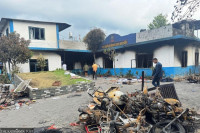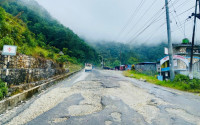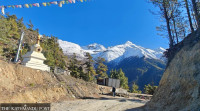Gandaki Province
Quake survivors say houses handed over by NRNA have weak doors and windows
Only 16 families have moved to the new settlement built for 573 earthquake-displaced families in Gupsipakha, Gorkha, till date.
Hariram Upreti
Tej Bahadur Gurung of Laprak, Gorkha, is planning to replace the doors and windows of his new house that was handed over to him by the Non-Resident Nepali Association (NRNA). It will cost him at least Rs 15,000 to replace the UPVC doors and windows, he estimates. UPVC, also known as Unplasticised Polyvinyl Chloride, is a low-maintenance building material used as a substitute for wood.
Tej Bahadur is not the only one planning to replace the doors and windows of the houses built by the NRNA for the survivors of the 2015 earthquake at Gupsipakha. Most of the families are busy removing the UPVC doors and windows of their houses these days. But they are also worried about the expenses of installing new wooden doors and windows.
“The construction of the houses is complete. But we need to replace the doors and windows since they are very weak,” said Chamsing Gurung. “The houses are there but the major work on the interiors is yet to be done. We have to bear the expenses of the replacement and we don’t know how we will be able to afford it.”
The NRNA has built an integrated settlement for 573 earthquake-affected families at Gupsipakha but the most of the beneficiaries are yet to move into their new houses.
Only 16 families of the total 573 have shifted to their new homes.
Basanta Gurung said they were worried about the structural integrity of the new houses.
“It’s not just the doors and windows, even the zinc sheet roofs look weak. We are not planning to replace the roof now since we don’t have the money,” said Gurung.
Technicians also admit using substandard materials while installing doors and windows for the houses which the authorities had touted as a “model integrated settlement”.
“UPVC panels have been used to make the doors and windows. Such materials are not solid,” said Ramsharan Acharya, chief at the district project implementation unit of the National Reconstruction Authority.
The local people have accused the NRNA of using shoddy materials while constructing the integrated settlement.
“The NRNA representatives showed us some fine quality of zinc sheets, doors and windows before the construction. The materials shown at that time have been used only in four/five houses,” said Ganesh Gurung, whose family has been living in a temporary hut since the earthquake. “I am planning to shift to the new house only after replacing the doors and windows.”
Ganesh said that the NRNA representatives were in a hurry to hand over the houses without completing the works. According to him, the construction of around 150 toilets is yet to be completed.
The NRNA started constructing the settlement in November 2016 after signing an agreement with the National Reconstruction Authority. The original plan was to complete the project within eight months.
Four years have passed since the project started, and it is still incomplete.
The NRNA has claimed that the project got delayed due to difficult terrain, harsh weather conditions and poor road condition, which hindered the smooth transportation of construction materials.
The site is about 30 minutes’ walk from the settlement of Laprak, which was severely ravaged in the earthquake and deemed uninhabitable by geologists.
Besides building 573 homes with running water and solar-powered electricity facilities, the NRNA had also announced plans to build a school, a health post and a Gurung museum at the settlement that is spread over 18 hectares of land.
Raj Gurung, the chairman of Dharche Rural Municipality Ward No. 4, said while there was some truth to the NRNA’s claim about difficult topography and adverse weather conditions delaying the project, the lack of coordination among the authorities involved in the project had also led to the delay.
“The local unit, National Reconstruction Authority and NRNA are all responsible for the delay. Coordination among them was clearly lacking,” he said.
The NRNA has said that it was aware of the concerns raised by the earthquake survivors.
“We have received complaints from the locals regarding the quality of doors and windows of their new homes. We are studying the issue, Naresh Rana, the executive director of NRNA Secretariat, said.




 8.12°C Kathmandu
8.12°C Kathmandu.jpg)










